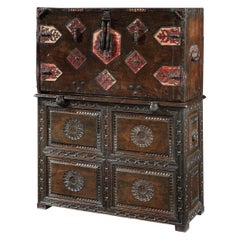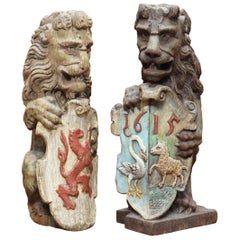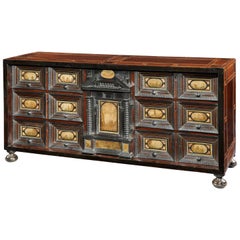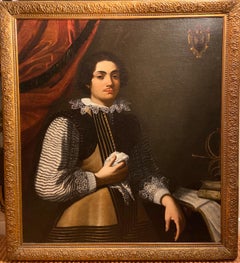England
to
1
83
469
237
81,367
52,843
35,261
30,949
23,527
18,592
17,762
12,767
7,539
7,199
7,150
6,001
5,502
5,380
4,984
4,885
4,102
3,893
3,866
3,716
3,646
2,751
2,597
2,167
2,047
1,801
1,238
1,105
1,094
1,056
753
707
591
591
570
566
539
515
343
297
274
200
174
157
142
129
100
90
83
64
62
54
54
42
39
29
22
16
13
13
9
6
1
1
1
1
1
Period: Early 17th Century
Vargueno, Bargueno, Escritorio, Taquillon, Spanish, Baroque, Walnut, Velvet
Located in BUNGAY, SUFFOLK
Spanish writing desks of this period are the most distinctive pieces of Spanish furniture conceived as visual displays of incredible virtuosity. The characteristic decoration of the ...
Category
Early 17th Century Spanish Baroque Antique England
Materials
Walnut
Pair of 1615 English Polychrome Painted Heraldic Lion Newel Banisters Finials
Located in GB
Wer are delighted to offer this exceptionally rare pair of King James 1st 1615 English Heraldic Lion Newel Finials with period Polychrome paint
Where ...
Category
1610s English Jacobean Antique England
Materials
Oak
Table Cabinet, Early 17th Century, Italian Baroque, Pietra Paesina Mounted Walnu
Located in BUNGAY, SUFFOLK
This cabinet is one of a small group that were made in the 1620s as taste and fashion veered towards the use of a paesina stone with its characteristic evocative veining which exhibi...
Category
Early 17th Century Italian Baroque Antique England
Materials
Marble
17th Century Italian Oil Painting Portrait of Music Prodigy Girolamo Frescobaldi
Located in London, GB
Portrait of Girolamo Frescobaldi (1583-1643)
Attributed to Antiveduto Della Grammatica (1571-1626)
Oil on Canvas
1605-1609
Framed in a Nineteenth Century gild and composite frame
44....
Category
Early 17th Century Baroque England
Materials
Oil
Table Rent Center Desk Tavolino Tuscan Italian Walnut Oval Baroque
Located in BUNGAY, SUFFOLK
Exceptionally rare, large, museum quality, Tuscan, Baroque, walnut, rent or center table or tavolino with detachable top and single drawer
- This beautiful, rent table is an unco...
Category
Early 17th Century Italian Baroque Antique England
Materials
Walnut
Arcon Chest Coffer Leather Armorial Spanish Baroque Gilded Brass Studwork Domed
Located in BUNGAY, SUFFOLK
Rare, early 17th century, Spanish, leather, ‘Arcon’ or domed travelling coffer with a gilded armorial & ornamented with brass studwork.
Surviving utalitarian pieces such as travel...
Category
1620s Spanish Baroque Antique England
Materials
Leather
Armchair Throne Pair Italian Walnut Red Mohair Velvet Armorial Renaissance
Located in BUNGAY, SUFFOLK
A rare pair of late-Renaissance, Italian, upholstered, walnut, throne, open, armchairs or coppia di seggioloni, retaining their original armorials
These throne armchairs are charact...
Category
Early 1600s Italian Renaissance Antique England
Materials
Walnut
Antique David Eckrich German Silver Tankard
By David Eckrich
Located in Jesmond, Newcastle Upon Tyne
An exceptional, fine and impressive, rare antique German silver quart tankard; an addition to our range of collectable 17th century silverware
This exceptional antique German silver tankard has a plain tapering cylindrical form onto a circular shaped domed foot.
The surface of this antique tankard is embellished with impressive partial gilt chased scrolling decoration accented with central fruit and floral sprays in addition to undulating leaf designs, all on a matte background.
The upper rim of this lady's tankard is encompassed with an applied moulded border.
This rare silver tankard retains the original domed cover encircled with further chased scrolling ornamentation, reflecting that of the body and features a cast figural thumbpiece.
The plain domed portion of the cover is surmounted with the original and impressive cast tiered finial.
The impressive cylindrical hinge is ornamented with further matte textures.
This antique German tankard...
Category
Early 17th Century German Antique England
Materials
Silver
Queen Anne Antique Sterling Silver Porringer / Bowl / Bleeding Bowl, 1710
By James Rood
Located in London, GB
An excellent Queen Anne solid silver bleeding bowl / dish with a magnificent pierced handle. The bowl has a slightly bellied shape with a narrow straight...
Category
Early 17th Century English Queen Anne Antique England
Materials
Sterling Silver
Antique Charles I English Sterling Silver Chalice
Located in Jesmond, Newcastle Upon Tyne
An exceptional, fine and impressive antique Charles I English sterling silver chalice; an addition to our collectable range of 17th century silverware.
This exceptional antique Char...
Category
1620s Great Britain (UK) Antique England
Materials
Sterling Silver
Countye of Monmouth, Dated 1610
By John Speed
Located in BUNGAY, SUFFOLK
The countye of Monmouth with the situation of the townshire described Anno, 1610
The reverse with Monmouthshire, Chapter VI and an alphabetical list of towns.
In a beautiful Flemish oak polished and gilded frame
Cartographer: John Speed...
Category
1610s English Baroque Antique England
Materials
Paper
Spanish School Early 17th Century Oil Painting of Christ and the Virgin Mary
Located in London, GB
An early 17th century painting in oil on canvas from the Spanish School depicting the Lamentation of Christ.
In this moving depiction of the Lamentation Christ...
Category
Early 17th Century Spanish Renaissance Antique England
Materials
Paint
Iconic Disderot 5980 Wall Lamp/Sconce Numbered with Certificate
Located in London, GB
This is the first lamp designed by Alain Richard. It defined his style: Functional, elegant and simple with a precise sense of design and proportion.
Available in its original format...
Category
Early 17th Century Antique England
Materials
Agate
Pair of Windows, 17th Century Flemish Baroque, Original Shutters & Ironwork
Located in BUNGAY, SUFFOLK
Exceptionally Rare Pair Of 17th Century, Flemish, Windows, 17th Century Flemish Baroque, Original Limewash, Shutters, Glazing & Ironwork
These windows have come from the property th...
Category
Early 17th Century European Baroque Antique England
Materials
Oak
Michael Drayton 1622 Cambridgeshire Map for Poly-Olbion original antique vintage
By Michael Drayton
Located in London, GB
Visit our other items to see a large selection of views of Oxford and Cambridge.
Michael Drayton (1563-1631)
Map of Cambridge and the Isle of Ely (1...
Category
1620s Surrealist England
Materials
Engraving
German Baroque Centre Table with Marquetry Inlays
Located in London, GB
Produced in Germany during the early 17th Century, this table is Baroque in style and period. The table stands on four rectilinear legs, their square profiles tapering from top to bo...
Category
Early 17th Century German Baroque Antique England
Materials
Maple, Walnut
Chair Backstool Set of 5 Renaissance Oak English Architectural Velvet Sage Green
Located in BUNGAY, SUFFOLK
A set of exceptionally rare, English, late-Renaissance, oak, architectural, backstools upholstered in a sage green 19th century Renaissance-revival velvet
- The architectural insp...
Category
Early 1600s English Renaissance Antique England
Materials
Oak
Chest, Coffer, 17 Century, German, Baroque, Oak, Marquetry, Inlay, 30 cubic feet
Located in BUNGAY, SUFFOLK
This vernacular chest exudes character and charm. The moulded panels and inlay inject gravitas. It has a lovely mellow lustrous patina. It is unusual being large and providing a copi...
Category
Early 17th Century German Baroque Antique England
Materials
Oak
Trestle Gateleg Table, Museum Piece English Jacobean Cedarwood, Panelled
Located in BUNGAY, SUFFOLK
- This table is the most original and superior example of a small surviving group of a rare, early model of gateleg table dating between 1620 and 1650.
- It is more sophisticated t...
Category
Early 17th Century English Jacobean Antique England
Materials
Cedar
Portrait of William Herbert, 3rd Earl of Pembroke, Early 17th Century Portrait
Located in London, GB
English School, (circa 1600)
Portrait of William Herbert, 3rd Earl of Pembroke
Oil on panel, oval
Image size: 29¼ x 23⅞ inches
Painted wooden frame
Provenance:
176, Collection of Francis Greville, 1st Earl of Warwick.
The Trustees of the Lord Brooks’ Settlement, (removed from Warwick Castle).
Sotheby’s, London, 22nd March 1968, lot 81.
Painted onto wooden panel, this portrait shows a dark haired gentleman in profile sporting an open white shirt. On top of this garments is a richly detailed black cloak, decorated with gold thread and lined with a sumptuous crimson lining. With the red silk inside it’s all very expensive and would fall under sumptuary laws – so this is a nobleman of high degree.
It’s melancholic air conforms to the contemporary popularity of this very human condition, evident in fashionable poetry and music of the period. In comparison to our own modern prejudices, melancholy was associated with creativity in this period.
This portrait appeared in the earliest described list of pictures of Warwick castle dating to 1762. Compiled by collector and antiquary Sir William Musgrave ‘taken from the information of Lord & Lady Warwick’ (Add. MSS, 5726 fol. 3) is described;
‘8. Earl of Essex – an original by Zuccharo – seen in profile with black hair. Holding a black robe across his breast with his right hand.’
As tempting as it is to imagine that this is a portrait of Robert Devereux, the 2nd Earl Essex, we might take this with a pinch of salt. Its identification with this romantic and fatal Elizabethan might well have been an attempt to add romance to Warwick Castle’s walls. It doesn’t correspond all that well with Essex’s portraits around 1600 after his return from Cadiz. Notably, this picture was presumably hung not too far away from the castle’s two portraits of Queen Elizabeth I. The first, and undoubtedly the best, being the exquisite coronation portrait that was sold by Lord Brooke in the late 1970s and now hangs in the National Portrait Gallery. The second, described as being ‘a copy from the original at Ld Hydes’, has yet to resurface.
The portrait eventually ended up being hung in the State Bedroom of Warwick Castle.
Archival documents present one other interesting candidate. The Greville family’s earliest inventory of paintings, made in 1630 at their home Brooke House in Holborn, London, describes five portraits of identified figures. All five belonged to the courtier, politician and poet Sir Fulke Greville (1554-1628), 1st Baron Brooke, and were hung in the ‘Gallerie’ of Brooke House behind yellow curtains. One of them was described as being of ‘Lord of Pembrooke’, which is likely to have been William Herbert (1580-1630), 3rd Earl of Pembroke. William was the eldest son of Greville’s best friend’s sister Mary Sidney, and was brought up in the particularly literary and poetically orientated household which his mother had supported. Notably, the 3rd Earl was one of the figures that Shakespeare’s first folio was dedicated to in 1623.
The melancholic air to the portrait corresponds to William’s own pretensions as a learned and poetic figure. The richness of the robe in the painting, sporting golden thread and a spotted black fabric, is indicative of wealth beyond that of a simple poet or actor. The portrait’s dating to around the year 1600 might have coincided with William’s father death and his own rise to the Pembroke Earldom. This period of his life too was imbued with personal sadness, as an illicit affair with a Mary Fitton had resulted in a pregnancy and eventual banishment by Elizabeth I to Wilton after a short spell in Fleet Prison. His illegitimate son died shortly after being born. Despite being a close follower of the Earl of Essex, William had side-stepped supporting Devereux in the fatal uprising against the Queen and eventually regained favour at the court of the next monarch James I.
His linen shirt is edged with a delicate border of lace and his black cloak is lined on the inside with sumptuous scarlet and richly decorated on the outside with gold braid and a pattern of embroidered black spots.
Despite the richness of his clothes, William Herbert has been presented in a dishevelled state of semi-undress, his shirt unlaced far down his chest with the ties lying limply over his hand, indicating that he is in a state of distracted detachment. It has been suggested that the fashion for melancholy was rooted in an increase in self-consciousness and introspective reflection during the late 16th and early 17th centuries.
In contemporary literature melancholy was said to be caused by a plenitude of the melancholy humor, one of the four vital humors, which were thought to regulate the functions of the body. An abundance of the melancholia humor was associated with a heightened creativity and intellectual ability and hence melancholy was linked to the notion of genius, as reflected in the work of the Oxford scholar Robert Burton, who in his work ‘The Anatomy of Melancholy’, described the Malcontent as ‘of all others [the]… most witty, [who] causeth many times divine ravishment, and a kind of enthusiamus… which stirreth them up to be excellent Philosophers, Poets and Prophets.’ (R. Burton, The Anatomy of Melancholy, London, 1621 in R. Strong, ‘Elizabethan Malady: Melancholy in Elizabethan and Jacobean Portraits’, Apollo, LXXIX, 1964).
Melancholy was viewed as a highly fashionable affliction under Elizabeth I, and her successor James I, and a dejected demeanour was adopted by wealthy young men, often presenting themselves as scholars or despondent lovers, as reflected in the portraiture and literature from this period. Although the sitter in this portrait is, as yet, unidentified, it seems probable that he was a nobleman with literary or artistic ambitions, following in the same vain as such famous figures as the aristocratic poet and dramatist, Edward de Vere...
Category
Early 17th Century Old Masters England
Materials
Wood Panel, Oil
17th Century Italian Inlaid Mirror
Located in London, by appointment only
Rare 17th century Neapolitan ebony and bone inlaid walnut giltwood mounted toilet mirror. The rarity of this small piece cannot be overstated. The veneered inlaid columns are superb ...
Category
Early 17th Century Italian Renaissance Antique England
Materials
Walnut, Ebony, Bone
Museum Quality Antique Stuart 17th Century Rock Crystal Love Knot Ring
Located in London, GB
Stuart rock crystal love knot ring. The central oval rose cut domed rock crystal in closed back collet setting, surmounting a complicated love knot in gold thread, to a D-shape shank...
Category
Early 17th Century Stuart Antique England
Materials
Rock Crystal, Crystal, Yellow Gold
Late Elizabethan Oak Refectory Table , Circa 1600
Located in Hoddesdon, GB
An English Oak Refectory Table, dating back the late Elizabethan period . circa 1600, a rare and stunning example . The table is surprisingly original . Retaining all its original...
Category
Early 1600s British Elizabethan Antique England
Materials
Oak





